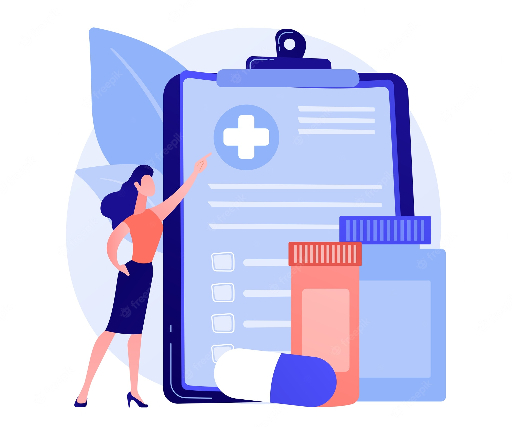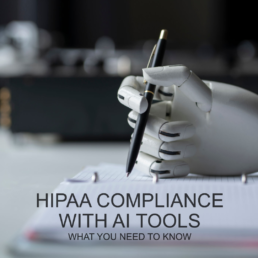Artificial Intelligence in Healthcare

The Power of AI
AI, or Artificial Intelligence, refers to the field of computer science that focuses on creating intelligent machines capable of performing tasks that typically require human intelligence. AI encompasses various techniques and algorithms, such as machine learning, natural language processing, and computer vision, to enable machines to perceive, learn, reason, and make decisions.
OpenAI is an organization that conducts extensive research and development in the field of AI. It aims to ensure that artificial general intelligence (AGI) benefits all of humanity and is committed to producing AI technologies that are safe, beneficial, and accessible. OpenAI has developed advanced language models, including GPT-3.5, to improve natural language understanding and generate human-like responses to a wide range of queries.
HIPAA Compliance
When it comes to sending Protected Health Information (PHI) to a computer running Artificial Intelligence (AI), there are potential challenges related to maintaining HIPAA compliance. HIPAA, the Health Insurance Portability and Accountability Act, sets standards for the privacy and security of individually identifiable health information. AI technology has the potential to revolutionize healthcare, but it must be used in a manner that aligns with HIPAA regulations to ensure patient privacy and data security.
One of the key considerations for using AI in healthcare is the implementation of de-identification methods. De-identification involves removing or altering certain identifiers from the health data to prevent the data from being linked to specific individuals. The HIPAA Privacy Rule provides guidelines for de-identification, and one recommended technique is known as the "Safe Harbor" method. This method involves removing identifiers such as names, addresses, dates, telephone numbers, Social Security numbers, and medical record numbers.
By applying the Safe Harbor method, organizations can eliminate specific identifiers that could be used to identify individuals. The rationale behind de-identification is that without these identifiers, the data no longer qualifies as personally identifiable health information (PHI) or personally identifiable information (PII). De-identified data can then be used for AI analysis without violating HIPAA regulations.
At Office Puzzle, we understand the importance of maintaining HIPAA compliance while utilizing AI in healthcare. We have taken steps to ensure that our AI models comply with HIPAA regulations, and we prioritize the protection of PHI throughout the entire process. By implementing appropriate de-identification techniques and robust security measures, we aim to harness the power of AI while safeguarding patient privacy and adhering to HIPAA guidelines.
You can read more about how to remain HIPAA compliant while using artificial intelligence (AI) in our blog post: https://www.officepuzzle.com/article/ai-models-in-healthcare-and-hipaa-compliance/.
We are proud to announce that Office Puzzle is now leveraging artificial intelligence in specific areas of our platform. By integrating AI technology, we strive to enhance the efficiency and effectiveness of healthcare processes while maintaining the utmost respect for patient privacy and data protection.

Autocomplete
This feature has been a core component of Office Puzzle since its inception and has undergone three updates to enhance its functionality. The most recent update introduces AI technology, elevating the clinical note process to a more comprehensive level. The note's content is derived from an actual questionnaire, captured through dropdowns and session-specific details, resulting in a summary note that users can review and approve before submitting.
Rest assured, the protection of personal health information (PHI) is of utmost importance. Prior to processing, all information is meticulously anonymized, ensuring that no PHI is transmitted to the AI. This robust anonymization process guarantees the privacy and confidentiality of user data while the note creation.
We make to ensure data safety are as follows:
- To ensure the protection of personal information, we employ a strict redaction process prior to submission. For instance, a text such as:"The services were provided at the agreed-upon time, Sarah and BCBA were present at the client's school." is transformed into: "The services were provided at the agreed-upon time, {{clientName}} and BCBA were present at the client's school.". By implementing this redaction technique, we eliminate the possibility of identifying individuals within the note. Once we receive the response, we securely restore the client's name within a HIPAA-compliant environment, ensuring privacy and compliance with regulations.
- Our approach to utilizing AI involves strict instructions to avoid content modification in any form. The AI's sole purpose is to rectify grammar errors and enhance readability. By adhering to this instruction, we ensure that the AI does not generate any independent ideas but remains confined to the user's input.

Data Analysis
Data Analysis is a valuable feature within Office Puzzle, designed to empower providers with a comprehensive overview of their data. By utilizing this feature, providers can swiftly identify trends and patterns within their data, enabling them to gain valuable insights. By inputting data collected over the past 6 months, the algorithm generates a concise analysis, giving a clear picture of the progress made thus far.
This feature significantly reduces the need for manual analysis, which often carries the risk of errors or prolonged processing times. By automating the data analysis process, providers can save valuable time and effort while obtaining accurate and reliable results. The Data Analysis feature serves as a powerful tool to streamline the analysis process, allowing providers to make data-driven decisions with confidence.
Providing a table full of data like this:
| Name | Baseline | January 2023 | February 2023 | March 2023 | April 2023 | May 2023 | June 2023 |
| Noncompliance | 90 | 89.05% | 85.53% | 82.57% | 79.22% | 77.79% | 75% |
| Mouthing | 32 | 31.5 | 28.5 | 28.4 | 27.25 | 26.5 | 25.75 |
| Physical Aggression | 42 | 40.75 | 39.75 | 36.8 | 37.25 | 35.5 | 34.5 |
| Elopement | 33 | 30.75 | 27.5 | 27.4 | 26.25 | 25.5 | 24.75 |
| Tantrums | 55 | 54.5 | 47.5 | 45.2 | 45 | 42.75 | 42.25 |
| Climbing | 34 | 33.75 | 29.25 | 29.2 | 30.5 | 29 | 27.5 |
| Hyperactivity | 62 | 61.25 | 52.75 | 51 | 51.5 | 51 | 50.25 |
The AI can generate a summary:
Based on the data provided for the last 6 months, here is a summary of the trends and progress:
- Noncompliance: There has been a steady decrease in noncompliance rates from January to June, indicating progress in this area. The baseline of 90% has decreased to 75%.
- Mouthing: The rates of mouthing behavior have shown a consistent decline over the last 6 months. This suggests progress in managing this behavior.
- Physical Aggression: Although there have been slight fluctuations, the overall trend for physical aggression is showing a slight decrease. This indicates some progress in addressing this behavior.
- Elopement: Elopement rates have been steadily decreasing, suggesting progress in managing this behavior over the last 6 months.
- Tantrums: There has been a general decline in tantrum behavior over the past 6 months. While there are minor fluctuations, the overall trend shows progress in reducing tantrums.
- Climbing: The climbing behavior has shown some variation, but there is no significant trend observed in the data for the last 6 months.
- Hyperactivity: Hyperactivity rates have remained relatively stable over the past 6 months, with a slight decrease observed in the most recent month. There is limited progress in managing hyperactivity.
Overall, there has been progress in managing noncompliance, mouthing, physical aggression, elopement, and tantrums. However, climbing behavior and hyperactivity have shown limited progress.

Service Plan
Coming soon!
--
Office Puzzle allows providers to shift focus back to patient care. All this while being compliant when performing their daily tasks. They use technology to solve most of the communication challenges, creating a more collaborative, transparent, and simpler exchange of information between providers and the agency staff.
How to use ChatGPT ensuring HIPAA compliance
Artificial intelligence (AI) has the potential to revolutionize the way we deliver medical care, from scheduling appointments to creating personalized treatment plans. However, it's crucial to understand the potential risks of using AI in healthcare, particularly in HIPAA-compliant environments, before delving into the basics of AI and GPT-4. Although AI language models like ChatGPT offer numerous benefits, compliance with HIPAA regulations is essential to maintain patient confidentiality and protect sensitive data. It's also important to note that while AI is revolutionary, it is not yet ready for widespread use in all aspects of our lives. At Office Puzzle, we believe that understanding AI, GPT-4, and HIPAA compliance is crucial for anyone interested in implementing AI language models in their practice.
AI and GPT-4: Understanding the Basics
AI refers to computer systems that can perform tasks that typically require human intelligence. ChatGPT is an AI language model developed by OpenAI that can process natural language and write human-like text. GPT-4, or Generative Pre-trained Transformer 4, is an advanced AI model that builds on the capabilities of ChatGPT to answer questions, summarize text, and generate patient emails.
HIPAA Compliance Basics
HIPAA or the Health Insurance Portability and Accountability Act is a law that sets specific standards for maintaining the privacy and security of a patient's health information, known as Protected Health Information (PHI). Healthcare providers must follow HIPAA regulations when using AI language models like ChatGPT to ensure that PHI is protected and patient confidentiality is maintained. The incorporation of artificial intelligence (AI) language models in healthcare has the potential to revolutionize the industry. However, healthcare providers must ensure that their use of these models is in compliance with the Health Insurance Portability and Accountability Act (HIPAA) to safeguard patient privacy and prevent data breaches. Here are some strategies that healthcare providers can use to ensure HIPAA compliance when using AI language models:
- Data Storage and Transmission: Healthcare providers should ensure that sensitive patient data is stored and transmitted securely, with data encryption both at rest and in transit. AI language models should be hosted on secure and compliant infrastructure such as private clouds, on-premises servers, or HIPAA-compliant cloud services.
- De-identification: To reduce the risk of data breaches, PHI should be de-identified or anonymized. AI language models should be trained to recognize and redact personally identifiable information before processing the data.
- Access Control and Auditing: Access to PHI and the AI language model should be restricted to authorized personnel only. Regular audits should be conducted to monitor compliance and identify potential vulnerabilities.
- Data Sharing and Consent: The use of AI language models should comply with data-sharing agreements and patient consent. Healthcare providers should collect, process, and store data in accordance with HIPAA guidelines.
- Minimizing Bias: AI language models can unintentionally perpetuate biases present in their training data. Healthcare providers must take steps to minimize these biases and ensure that the AI model's outputs are unbiased.
In addition to these strategies, healthcare providers can also use AI language models like ChatGPT in a variety of settings to improve patient care. Here are some potential use cases:
- Appointment Scheduling: ChatGPT can manage appointment scheduling and automate reminders while ensuring that all communication is HIPAA-compliant and that PHI is protected.
- Patient Triage: ChatGPT can help streamline patient triage by processing and summarizing patients' symptoms and medical history, enabling healthcare providers to make informed decisions more quickly.
- Treatment Plan Assistance: ChatGPT can assist healthcare professionals in developing personalized treatment plans by summarizing relevant medical literature and guidelines.
- Patient Education: Healthcare providers can use ChatGPT to create tailored patient education materials that are accurate, up-to-date, and easy to understand while safeguarding patient privacy.
In conclusion, AI language models have the potential to revolutionize healthcare by improving patient care and streamlining workflows. However, healthcare providers must ensure that their use of these models is in compliance with HIPAA guidelines to protect patient privacy and prevent data breaches. By following the strategies outlined above and using AI language models like ChatGPT in a responsible and ethical manner, healthcare providers can unlock the full potential of this technology.



